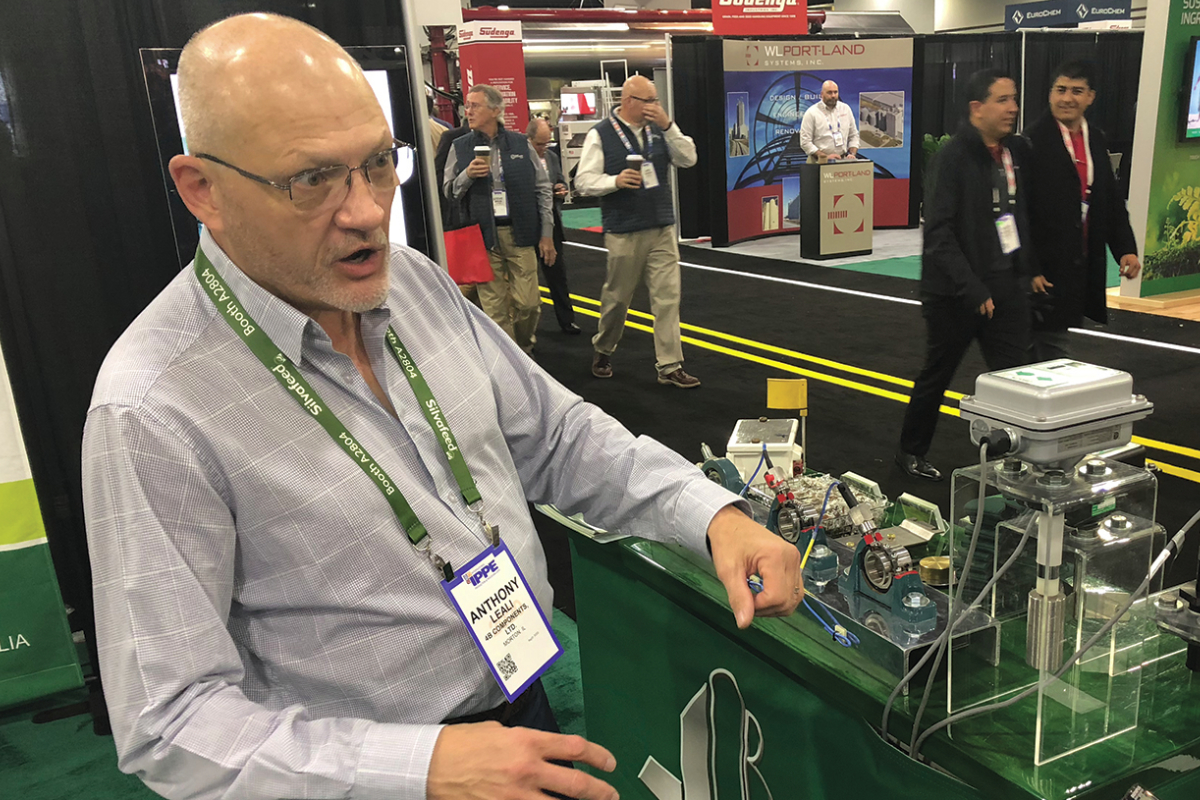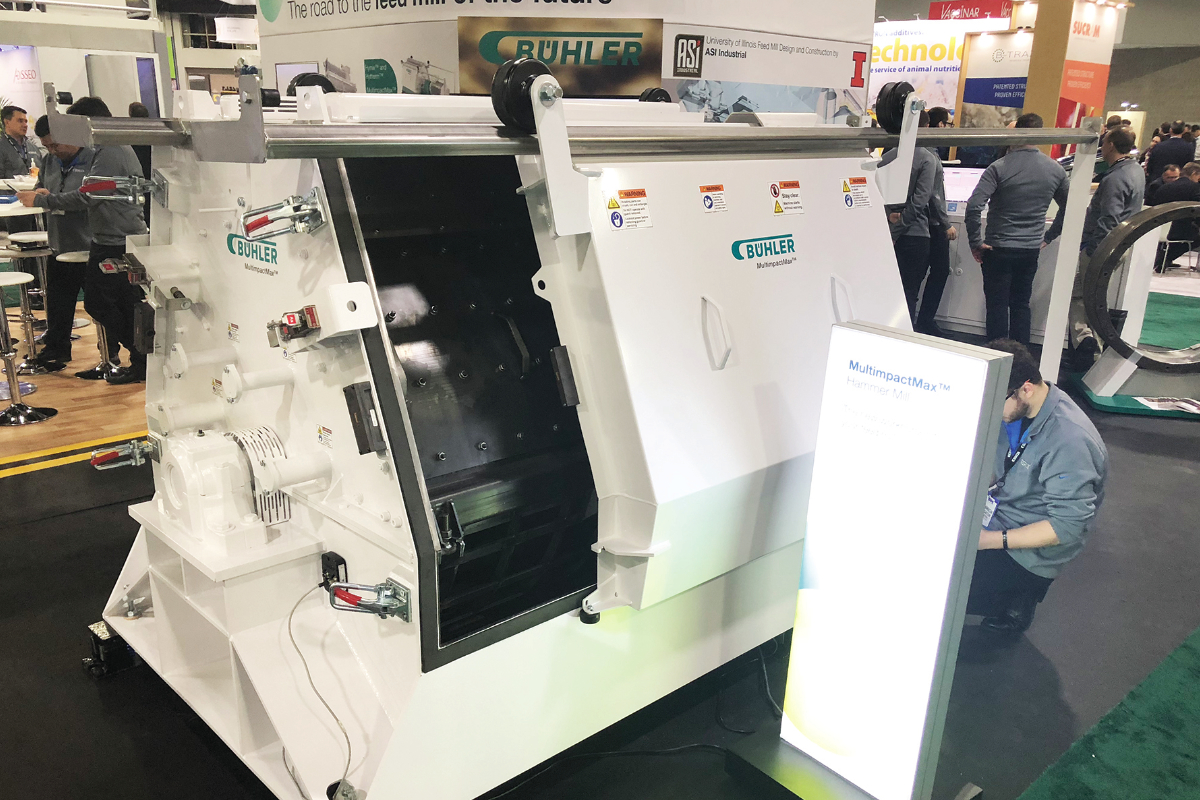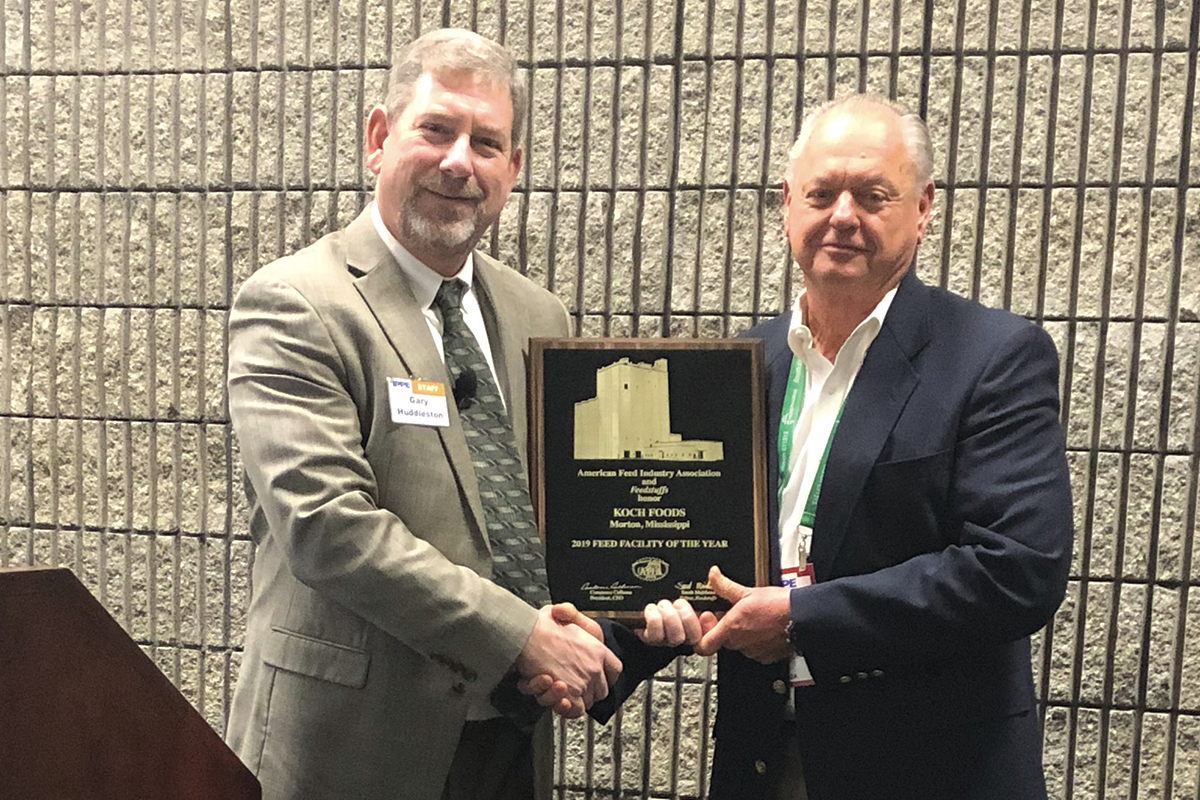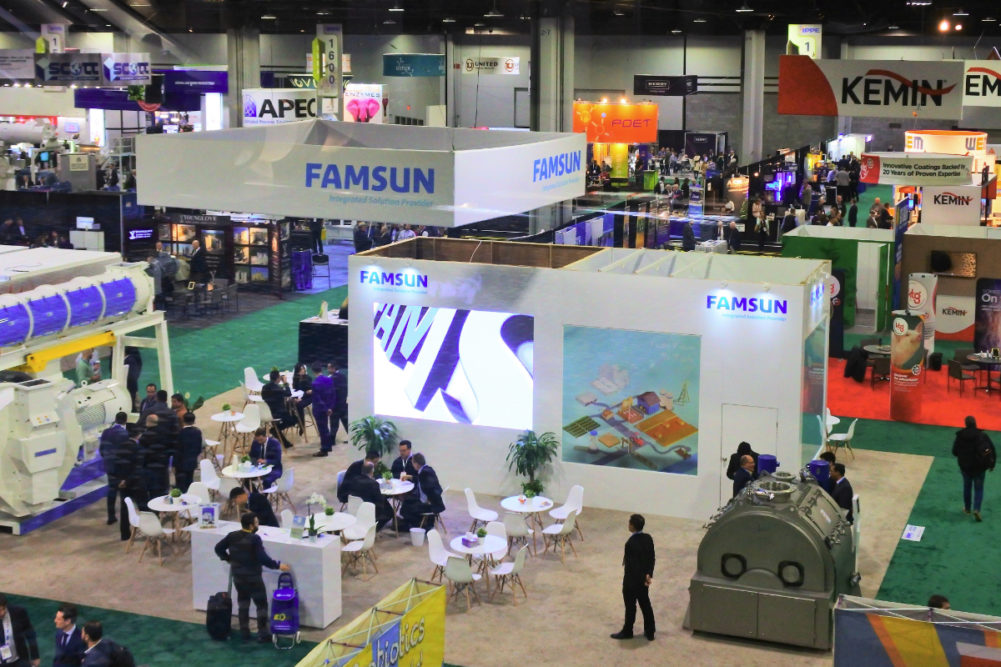Feed mills should consider implementing biosecurity measures to avoid spreading foreign animal diseases such as African swine fever (ASF) and avian influenza (AI), said presenters during the International Production & Processing Expo (IPPE).
The Foreign Animal Diseases presentation covered the potential sources of contamination at feed mills and livestock operations, as well as steps to prevent the introduction or spread of disease.
IPPE, held Jan. 28-30 at the Georgia World Congress Center in Atlanta, Georgia, U.S., attracted 32,000 attendees from all over the world and had more than 573,000 square feet of exhibit space and 1,376 exhibitors. The event was co-sponsored by the American Feed Industry Association (AFIA), U.S. Poultry & Egg Association and the North American Meat Institute.
“We are excited about the energy displayed by this year’s attendees and exhibitors,” remarked the three organizations. “The expanded trade show floor, including the new BC-Hall, and attendee and exhibitor numbers continue to complement IPPE’s unparalleled education sessions, invaluable networking opportunities and extensive exhibits showcasing the latest innovative technology, equipment and services for our industries.”
The large trade show floor remains the central attraction, with exhibitors displaying the most current technology in equipment, supplies and services. In addition, the show included a comprehensive education program with more than 200 hours of sessions, including the one on Foreign Animal Disease.
Foreign animal diseases such as ASF and AI are costly in loss of animals, trade disruptions, product quality and public relations challenges, said Bill Stanley with Aviagen, during the Foreign Animal Disease discussion.
“Biosecurity is something we all need to be thinking about,” he said. “We don’t need to wait until the disease is close at hand. What are the potential sources for the diseases my biosecurity system must prevent? You have to ask yourself these types of questions so you can go after these potential risks.”
Those risks include people, wild animals, feed, insects, rodents and equipment. While feed is not the most likely vehicle for disease transmission, because of the way it is manufactured and the way it is delivered, if a pathogen enters the feed supply chain the probability of infection is almost certain, said Cassie Jones, associate professor at Kansas State University.
“Once a virus enters a feed mill, it’s nearly impossible to eliminate,” she said.
KSU researchers learned this first-hand after purposely infecting a batch of feed at its Feed Safety Research Center with PEDV. Even after running four clean batches of feed through the mill, there was significant contamination on the equipment. Additionally, there was contamination on equipment within one meter of manufacturing and on surfaces more than three meters away.
“As soon as you introduce a virus into your feed mill, regardless of the method of introduction, you have the potential for that virus to not just effect the next batch of feed, but as you have people walking in and out, there becomes a risk for cross contamination as well,” Jones said.
Equipment had to be broken down, power washed, sanitized and eventually the mill was heated to 140 degrees for 48 hours.
“We can’t do that in normal production feed mills, so why do we need feed biosecurity? So that we don’t have to go through something like this,” she said.
Jones outlined some practices that can reduce risk but stressed there isn’t one magic bullet for protection. Rather, she described it as a series of hurdles.
“We know we have risks,” Jones said. “Our goal is to create enough hurdles that hopefully one of them will trip up that pathogen and keep it from getting into the mouth of an animal.”
She suggested excluding high-risk ingredients, including grains and oilseeds from regions with foreign animal disease.

“We are fortunate enough in the U.S. that we have enough grain and oilseeds available that we don’t need for economic reasons to be taking that risk,” Jones said.
If a feed mill is using other ingredients from regions with animal diseases, make sure that it’s delivered in a new tote or if it’s coming by truck, know what was in the loads immediately prior to the mill’s product. Jones also recommended inspecting and sanitizing the outside of the bags before they come into the mill.
She also said to use porcine-based ingredients with caution. While the manufacturing process should destroy viruses, there isn’t prevention of post-processing cross contamination. Feed mills should develop a biosecurity plan and an audit for it. This could include sanitizing floors regularly with a 10% bleach solution and avoiding dust as an ingredient in feed.
“Every time we test dust it has a very high pathogen load,” Jones said. “I understand that shrink is a very real thing, but I also want you to understand that it is a high-risk activity. It’s time for us to have a conversation about the cost benefit of continuing to use that dust, particularly in highly sensitive species like a pig.”
The plan could also include cleaning and disinfecting delivery trucks and receiving mats or funnels to limit pathogen entry through the receiving pit. Creating a clean and dirty line in a mill can limit contamination from people.
Workers would enter one direction to the “dirty” side with their street clothes and shoes, remove their shoes, and move to the clean side where they would put on clean shoes and then enter the mill.
Expo highlights safety and quality
With safety and quality continuing as major concerns for the feed industry, exhibitors at the IPPE were showcasing solutions with their automation and other latest technologies.
Bühler highlighted several of its automation solutions, including the Mercury MES, which it introduced during IPPE. The latest technology, based on its WinCos system, has a high level of reporting and analytics built into the control system for those who want a high level of automatic control in their facilities, said Dan Lundt, Bühler sales director, feed and oilseeds North America.
“With this type of feed mill, you can run it with fewer people,” he said. “The investment is higher in what the system can do but it offers the ability for fewer operators. It’s all web-based so nothing ever goes out of date. It’s easy to stay current with the hardware and software at a much lower cost.”
The Mercury system will be installed at the University of Illinois’ Feed Technology Center in Champaign-Urbana, Illinois, U.S., along with Bühler core equipment and its online NIR system. With that system, the placement of simple sensors can measure fat, moisture, protein allowing for predictive or regulating control, Lundt said.
“Now the mill can see the level of moisture and run the pellet mill based on that,” he said. “You can optimize the facility without any operator input. It becomes a really smart mill.”
Aside from the number of operators, the automation options ensure consistent quality and output, Lundt said.
“It’s really more about the quality and output at the lowest amount of cost,” he said. “It just makes feed milling more secure in the future.”

Bühler also displayed its Pluto system, an entry level web-based automation system.
“Whereas you might normally invest in thousands of hours in engineering the automation system, here in a couple of hours you can do automation for an entire feed mill with drag and drop,” Lundt said. “It’s a very quick, entry level type of system with a lot of power and features.”
In addition to the automation systems, Bühler highlighted sensors that can be added to various equipment to monitor performance. For example, a sensor can be added to a hammermill and provide analytic data so repairs can be done when needed rather than on a maintenance schedule, Lundt said. Bühler even showed how sensors can be added to a racecar that an employee races as a hobby. The car has been outfitted with Bühler sensors that are used in food production facilities.
“You can put this technology anywhere so it can improve a feed mill, a flour mill, or a race car, just as long as you apply it correctly and use the right analytics,” Lundt said.
AGI also showcased sensors and monitoring products, including its CMC hazard monitoring system.
“It makes sure everything in the plant is monitored,” said Jeff Trudell with AGI. “You don’t want any hot bearings or speed issues. If a conveyor is getting clogged, we want the operator to know that in real time. It can handle 144 sensors on just one module so you don’t have a large investment in equipment.”
The Winnipeg, Manitoba, Canada-based company had a part of its VIS FLEXMill on display. With a capacity from 10 to 25 tonnes per hour, the system is ideal for larger farmers or small elevators in the feed business.
“It’s like a small feed mill in a container for international shipment,” Trudell said. “There are lots of bolt-on components so it can be very simple or more complex, depending on what the needs are.”
With contamination being a constant concern for the feed industry, AGI displayed its TRAMCO round-bottom conveyor, which was been a feed industry favorite for more than 50 years.
“You get the energy conservation of moving material en masse style but with the round bottom, you get complete clean out,” Trudell said. “There’s no carryover when you add the next ingredient. It helps in the food safety side and with contamination, and also for load out. You can run different blends through there with no contamination.”
Trade was on the minds of IPPE exhibitors, especially the recent phase one agreement between the United States and China that ended the ongoing trade dispute that impacted agricultural products. Anthony Leali, 4B Components Ltd. business development manager, said the agreement will impact business.
“But it’s unknown,” he said. “When I talk to customers and other OEMs, everyone is like, we don’t know. No one has a good feel for what is going to happen.”
With phase one signed, Trudell said he’s hoping grain will start moving. If that happens, grain storage and handling companies will start upgrading equipment.
“That’s going to be great for us — new conveyors, new structures, new bucket elevators,” Trudell said.
But if grain doesn’t start moving and the incoming harvest is average, there still could be demand for equipment, including temporary storage options.
Not many people have faith in the phase one deal since China set up trading relationships outside of the United States during the trade dispute.
“I don’t see them breaking that off, unless the country they partnered with has some kind of crop failure,” Trudell said.
Feed Facility of the Year

Koch Farms’ feed mill in Morton, Mississippi, U.S., was named the 2019 Feed Facility of the Year during the American Feed Industry Association’s (AFIA) Feed Education Program on Jan. 29.
Frank Garczynski, plant manager, accepted the award on behalf of the 22 employees at the Koch Farms facility, which produces 800,000 tonnes of product annually serving more than 400 farms throughout Mississippi. It marked the second straight year that the Morton plant was named the mill of the year in the integrator category by the AFIA.
“Everyone at our plant works together and the end result is something really nice,” Garczynski said.
Gary Huddleston, director of feed manufacturing and regulatory affairs at the AFIA, presented the award to Garczynski. Huddleston praised the Koch Farms feed mill for its excellent housekeeping, its innovative biosecurity measures and for maintaining a positive employee culture.
“It made me want to go back and be a plant manager again when I toured this facility,” Huddleston said. “I used to tell everyone back when I was plant manager that I had the cleanest plant of anybody. I prided myself on that but, Frank, you make me jealous.
“You can literally walk through this plant with white gloves and not get any dust on them, which is just unheard of in an integrated facility that does that kind of tonnage.”
The Morton mill was built in 2009, and Garczynski noted that many of his employees have been with Koch Farms longer than that.
“Some came from the old mill,” said Garczynski, who has been in agriculture for 40 years, including 35 in the feed industry. “They never had really gotten any recognition. They’ve been expected to do their job and have done a fine job at that. Today they’re grinning in Morton, Mississippi.”
The plant, which operates 24 hours a day, five days a week, produces about 125 semi-truck loads of feed per day.
Located in a region that has dealt with AI, the Morton plant is known for going to great lengths to ensure that its feed product is not compromised. In 2015, it added a biosecurity spray station that disinfects trucks entering the facility.
“They have a strong focus on biosecurity,” Huddleston said. “If there’s a disease challenge, they are ready for it. It’s a very unique system they’ve got there.”
The annual AFIA award recognizes overall excellence in feed manufacturing operations, emphasizes the company’s commitment to safety, quality, regulatory compliance and employee development and highlights its overall operating efficiencies.
Formerly the Feed Mill of the Year Award, the AFIA and Feedstuffs modified the program in 2016, and it is now recognized as a first-class benchmarking program for the animal food industry. Representing each of the several types of feed manufacturing facilities within AFIA’s membership, the format compares and recognizes top-performing facilities in four categories: commercial dry livestock, integrator, liquid feed and premix. From those, the Feed Facility of the Year award is selected.
The AFIA recognized the category winners in January and honored them with plaques at the Feed Education Program. In addition to Koch Farms, which won the integrator category, the other winners were:
- Western Milling of Goshen, California, US, for the commercial dry livestock feed plant category.
- Quality Liquid Feeds of Menomonie, Wisconsin, US, for the liquid feed plant category.
- Trouw Nutrition of Nesoho, Missouri, US, for the premix manufacturing plant category.
FMT book update
The AFIA also announced it is nearing completion of phase one of its update of the Feed Manufacturing Technology (FMT) book. It will be available online for the first time, starting in 2020.
Offering the contents of the book online will make the FMT more accessible and easier for the AFIA to make updates, said Huddleston, who refers to the publication as the “feed industry Bible.”
The new FMT, last updated in 2010, will be available to AFIA members online for $299, with a per year renewal price of $50. The print version plus printed copy is available to members for $349 and $50 for annual renewal. Discounts are available for bulk purchases (25 or more) both online and in print. For more information, visit https://www.afia.org/.






